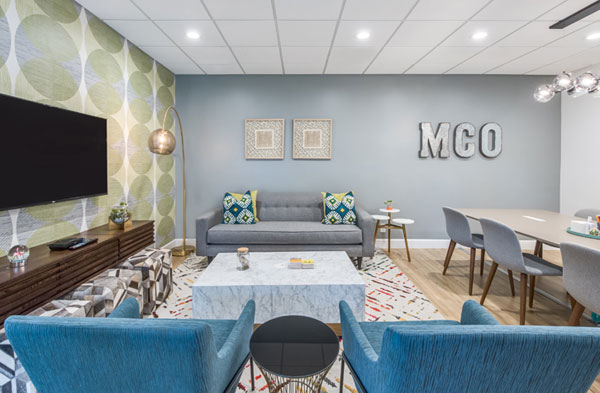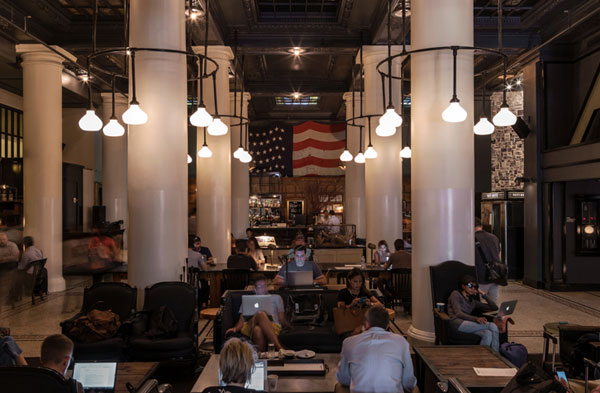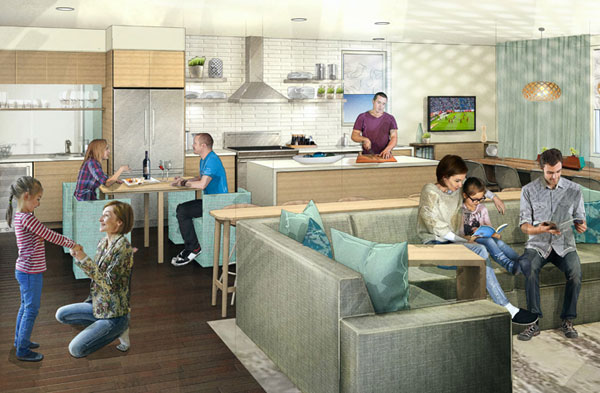✕

Column: industry Tag: hotel workspaces,hotel companie,guestrooms,social spaces Published: 2017-12-08 15:25 Source: Author:

Crowne Plaza will make its new Plaza Workspace, which includes a studio workspace guests can rent by the hour, a brand standard for properties going under renovation starting July 2018. (Photo: InterContinental Hotels Group)
REPORT FROM THE U.S.—The work habits of guests are changing, and hotel companies are changing their workspace offerings along with them.
While there are still business travelers who prefer to work in the privacy of their own guestrooms, many more travelers want the space and opportunity to work alongside other people, whether they are colleagues traveling as a group or they simply want to get out of their rooms and be in a livelier environment.
The changing work habits and need for more collaboration by business travelers is why the Crowne Plaza brand has introduced its Worklife guestrooms and Plaza Workspaces as part of its Accelerate Program, a three-year, $200-million-investment initiative by InterContinental Hotels Group in new innovations and marketing at the company’s hotels in the Americas region.
As part of the first phase of the Accelerate Program, Crowne Plaza introduced more than 3,000 Worklife guestrooms in the system, said Meredith Latham, head of Crowne Plaza at InterContinental Hotels Group. Those rooms are designed to give modern business travelers a place to rest and relax while also getting their work done as needed and yield a $20 premium above best flexible rate. Feedback from guests shows five to 10 points in higher guest satisfaction with the Worklife rooms compared to the standard guestroom, she said.
Also part of the first phase was the Plaza Workspace, a global change for the brand’s lobby and public spaces that focuses on four key components: service, food and beverage, at-a-touch technology and new modern design, Latham said. Part of it includes a studio space in the lobby that people can rent by the hour. It has a seating area, a table for smaller board meetings or brainstorming sessions with at-a-touch tech to ask for service. The Plaza Workspace is a “canned solution,” she said, which means it can be dropped into a hotel in as little as three weeks.
The company piloted six hotels with the Plaza Workspace in the United States, Latham said, and there are another 15 to 20 planned for 2018. Guest feedback has been positive; 95% said the room helped them collaborate with others and 100% said it helped them work on their own. Additionally, 95% of respondents said this addition would influence them to choose a Crowne Plaza over a competitor, she said.
As a result, the Plaza Workplace has been voted to become a brand standard for Crowne Plaza hotels in renovations beginning July 2018 in the next phase of the Accelerate Program, Latham said, and incentives will be available for early adopters. Based on the pilot program, the company believes the incremental revenue from the Plaza Workspace should show a return on investment within two years.
Social hubs
The concept behind Ace Hotels has always been based on the idea of friends creating social spaces, said Brad Wilson, president of Ace Hotel Group. The first property, Ace Seattle, was designed with social interaction in mind, he said, and the lobby had a communal table that allowed people do work together and hang out.
Ace Hotels executives spent a lot of time thinking about how people live and work, Wilson said, and they observed how people’s work habits have changed over time. The world where people needed to be physically connected to the Internet and printers doesn’t exist anymore, he said.
“It was not long ago hotels were bragging they had fax machines in their desks,” he said.

The Ace Hotel New York has a workspace in its lobby that acts as a community hub, where guests and locals alike spend their time working and socializing. (Photo: Ace Hotels)
The lobby of the Ace Hotel New York is probably the best-known in the portfolio, Wilson said, as it draws in a large number of non-hotel guests who use its lobby as a workspace throughout the day. The lobby offers a living space for travelers who have to be on the road but don’t want to sacrifice their lives, he said.
The public workspace in Ace Hotel Downtown Los Angeles is different from the one at the New York property, Wilson said. While the Ace Hotel New York workspace is driven by street traffic, people tend to drive to where they need to go in Los Angeles, he said. It’s a different lifestyle there, and many people do freelance work in which they do a lot of business over meals in more relaxed settings.
“In that building, the focus on the social/living aspect of work is much more on the roof, where we created roof gardens where people could sit outside in the shade,” he said. “You see people not far from the swimming pool, but they’re pounding away on a laptop.”
People like to be around other people, Wilson said. In the past, people would work quietly in private behind an office door or in a cubicle with high walls, and now, offices are open workspaces. People are less tied down with their technology, he said, which allows Ace Hotels to take a different approach to workspaces.
“I can work in spaces giving me more emotional security and interest,” he said. “People tune out of the chaos, sometimes with headphones, but they like to have the buzz and energy.”
Ace Hotels found the balance between being a hub for the city while also having space for guests to work, Wilson said. Guests like to see they’re in a place that’s interesting that draws in a lot of locals, he added.
“We’re going to see more and more focusing on how is this kind of live/work/eat/social environment morphing,” he said, adding that his company is looking at restaurants as workspaces with power outlets at every seat and all-day menus that can accommodate a working lunch.
“There’s a big blur between what is our life and what is our work in this world,” Wilson said. “If we want to meet their needs as travelers, we need to accommodate that in our hotels, to make the lifestyle in our hotels the lifestyles people are living.”
One size does not fit all
Marriott International targets business travelers with most of its brands, said Lionel Sussman, VP of global design strategies. That means the working environment is critical across the company’s portfolio.
The different brands appeal to different types of business travelers, he said, so the brands take individualized approaches to the guestroom and public-area workspaces. The premium classic brands, such as Marriott, Sheraton and Delta, generally have business travelers who need access to working space, so it’s designed to be front and center. The more experiential brands, such as Edition, W, Moxy and Element, still have workspaces, but they’re more discrete.

The Element brand will have a communal room connected to guestrooms that will provide groups of business travelers a private space where they can hold meetings, host parties or dinners. (Rendering: Marriott International)
Element recently introduced its communal room for guestrooms, Sussman said. It’s an area focused not only on the idea of working but on community and sharing by providing an area for a localized experience as a group or a family.
The space in the communal room is flexible, he said, offering different types of furniture that allow the room to host different types of work-focused meetings. The communal rooms can also host a little party or a private dinner because it includes a full kitchen.
For the flagship Marriott brand, Sussman said the company is creating workspaces in public spaces that are engaging and conducive to moments of collaboration and innovation. These workspaces will have flexibility built into them to make sure guests can use them in different ways, such as taking a more residential approach to the environment and elevating the food-and-beverage offerings.
“We’ll create varying levels of privacy so you can determine how/what types of meetings you want to engage in,” he said.
Marriott International is exploring different work surfaces in the guestroom across the different brands as well, Sussman said, as guests work in different ways depending on their length of travel and the purpose of their trip. The goal is to ensure the different guestrooms and brands provide opportunities to work informally in bed with an iPad and connectivity while also having a more formal desk in different markets.
“One of the things we also learned from testing different work surfaces is even though things are more mobile and the space is getting smaller, guests also need a place to land, to toggle things and really arrive in the guestroom and put all technology down,” he said.
Marriott has found that there isn’t one solution that fits all circumstances, Sussman said, and even one brand might have more than one solution. He noted the company is no longer in the business of cookie-cutter experiences, and that applies to all segments. The workspace design depends on the location because it needs to support the different types of business local venues and convention centers might generate.
The next step in hotel workspace evolution will be tied to community and sharing, going beyond the transactional piece into creating something meaningful to society and the specific location of the hotel, Sussman said.
“The reason we’re seeing more and more of these is people desperately are in need of meaningful human connections,” he said. “That’s why places like Starbucks are packed today. Any place that can create a sense of community will be where people want to be, to create connections, to come together for things bigger than a work meeting.”
Previous:First Avid Hotel breaks ground, to open in Q3 2018
Next:Rosewood Hotel Group Launches KHOS Hotel Brand
Hot key words
Hot Products
Popular Vendors